Read what Froebelian expert, Rachna Joshi, has to say about
Guildford Nursery School. The following is the seventh of her monthly blogs about aspects of Froebelian pedagogy at Guildford Nursery School.

The blocks and block area is a staple in many nurseries and settings, it’s an area that provides a myriad of learning opportunities for children and a space to observe children’s ideas come to life. At Guildford Nursery School (GNS) there is a large space dedicated to the blocks to provide children the space and time to explore and build with them.
Blocks today are based upon Froebel’s Gifts (Whinnett, 2020). They were adapted by American educator Caroline Pratt, then further adapted by Patty Smith Hill to create the large-scale blocks that we often see today. Community playthings continue to make the blocks that were designed by these American educators, but maintain the Froebelian ideas from the original Gifts.
When observing at GNS I saw that the space for the Blocks had coves for children to build in, meaning the children’s play had designated space which undoubtedly spilled out into the main part of the room, but this wasn’t an issue for the educators here, they understood and value block play and know that children’s creations can’t be kept in tidy spaces.
A child had created a boat using the blocks, she had balanced different shapes and added smaller blocks for details and symmetry. I asked her if she had been on a boat and she explained that she had at the weekend. Froebel talks about the forms: forms of life, beauty and knowledge. Here she is demonstrating these forms. The form of life through her experience of being on a boat at the weekend, the form of beauty through the symmetry in her building and the form of knowledge, knowing about the different parts of the boats and how they look and work.
Other children began to show interest in what she was creating, a child asked ‘Can I help you?’, ‘No’ she replied ‘I don’t need any help’. Her assertion is respected and children instead watch her build as she adds to her boat.
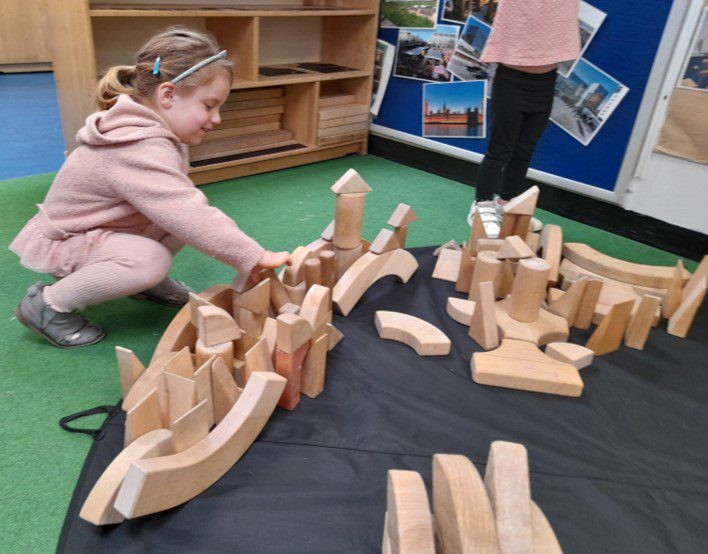
Her building demonstrates the stages of block play as described by Harriet Johnson (1933) encompassing the earlier stages of stacking, bridging and creating enclosures to create the boat based on her own experiences. Blocks also provide children with access to a multitude of areas for learning. For example, opportunities to develop communication and language by planning alongside peers to create a structure, understanding new words and concepts and applying this to their building.
For social and emotional development, there are huge links to working with others and managing and negotiating with others. Being resilient when things break and being confident to rebuild them, making choices and being autonomous. Being careful, safe and managing risks, considering heights and how to ensure safety of themselves and others. Carefully placing blocks to ensure balance requires physical skills.
Mathematical concepts are embedded into block play and provide children with real life understanding and application of theoretical concepts such as patterns, ratio, plane, angle, algebra.
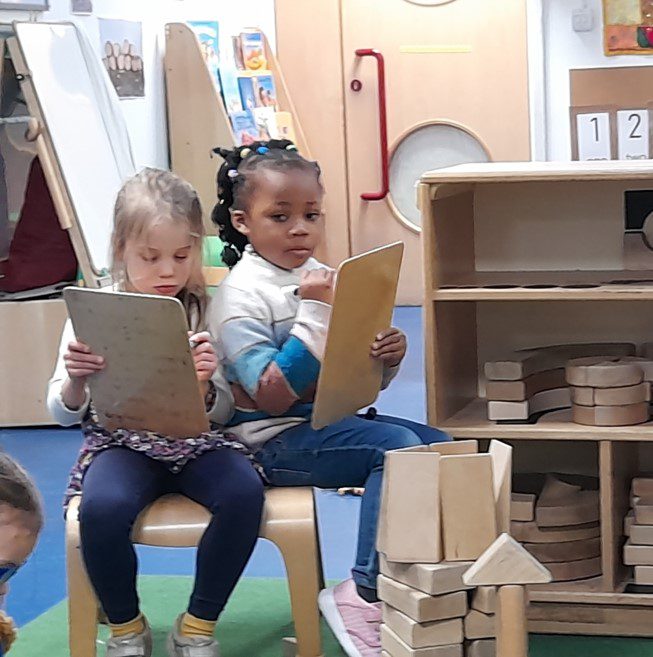
Like the child who created the boat, the blocks provide a deeper understanding of how things work, how a boat is created and what the different parts are. Concepts such as physics and engineering come into block play through children’s play.
Opportunities for writing are authentic and genuine, leaving children needing to write signs, posters, labels to enhance their building. Underpinning all these subjects is the innate need for children to represent and express themselves creatively. The blocks allow for open-ended play and affordances for whatever children feel like creating. They provide meaningful creations that are connected to children’s inner life.
Towards the end of the session the children are encouraged to tidy up, and this means that blocks need to be tidied away, if possible, they could be kept for the next day or session but if not then an option would be to take pictures of what was created. Then the task of putting everything back into the right place. Froebel emphasised the importance of organised environments and when setting up a block area the organisation needs to be carefully considered. The way in which they are presented to children helps them to understand mathematical concepts such as fractions. ‘Shadows’ or pictures can be used to organise the block area, these help children to match pictures and find the right shape and position to keep the blocks in. A well organised environment also promotes children’s independence, they are able to maintain the environment themselves, it develops ownership and care for things and reduces the workload for educators.
Finally, I want to touch on the ideas of blocks and construction. They are different things and educators need to be aware of the differences between them – there is value in both. Construction such as K’nex or Lego require more fine motor control, they stay in place which is useful when creating something like a plane that needs to fly. Lego is only fixed in one way, top and bottom, side to side. However a block can be placed in any direction in any plane. More recently, Lego comes with instructions to create a ‘set’ or outcome driven item, this can be frustrating and challenging and also short-lived. Children are not able to be creative when they are told what to make and how to make it.
I urge educators to look closely at the construction and blocks available in your setting. What is the learning potential with the construction you have? What about the blocks?
Reflect on your block areas, are they organised well? Are they set up for children to maintain themselves? Can you see the stages of block play in your children as they play? Can you see the Froebelian forms of life, beauty and knowledge? How do you support children in the block play area?
References
JOHNSON, H. 1933. The Art of Block Building. In: UNIVERSITY, C. (ed.). John Day Company.
Foundations: The value of block play, Directed by PLAYTHINGS, C.
WHINNETT, J. 2020. Froebel’s gifts and block play today. In: TRUST, F. (ed.).
